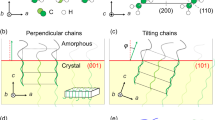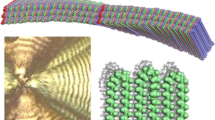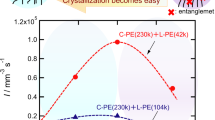Abstract
THE texture of crystalline polymers is typically one of thin (100 Å thick) lamellae within which the long (103–105 Å) molecules lie transversely in chain-folded configurations. In certain circumstances, however, much thicker lamellae, often as thick as the molecular length, have been observed in polyethylene1–3. An example is shown in .Fig. 1. Because a variety of evidence indicates little or no chain-folding in these layers (that is, the molecules, which lie across them, are essentially in extended configuration) they have become known as extended-chain lamellae (ECL) in contrast to the more familiar folded -chain lamellae (FCL). The circumstances in which ECL form are: (i) growth at low supercoolings for long times1 and (ii) by recrystallization under high pressure2,3. The layers themselves vary in thickness, being most regular in slowly crystallized samples1. In pressure crystallized material, thicknesses varying by a factor of two for the same lamella, and ten for different ones, have been observed3. ECL are also mechanically very different from FCL, because the toughening effect of molecules crystallizing through several lamellae must then be small. In fact ECL are no longer plastic but waxy as befits their paraffinoid structure. It is, however, the growth of ECL that has provided a long standing problem in polymer physics.
This is a preview of subscription content, access via your institution
Access options
Subscribe to this journal
Receive 51 print issues and online access
$199.00 per year
only $3.90 per issue
Buy this article
- Purchase on Springer Link
- Instant access to full article PDF
Prices may be subject to local taxes which are calculated during checkout
Similar content being viewed by others
References
Anderson, F. R., J. Appl. Phys., 35, 64 (1964).
Wunderlich, B., and Arakawa, T., J. Polymer Sci., A, 2, 3697 (1964).
Geil, P. H., Anderson, F. R., Wunderlich, B., and Arakawa, T., J. Polymer Sci., A, 2, 3707 (1964).
Statton, W. O., and Geil, P. H., J. Appl. Polymer Sci., 3, 357 (1960).
Hoffman, J. D., and Weeks, J. J., J. Chem. Phys., 42, 4301 (1965).
Wunderlich, B., J. Polymer Sci., B, 5, 7 (1967).
Keller, A., and O'Connor, A., Nature, 180, 1289 (1957).
Balta Calleja, F. J., Bassett, D. C., and Keller, A., Polymer, 4, 269 (1963).
Baer, E., and Kardos, J. L., J. Polymer Sci., A, 3, 2827 (1965).
Author information
Authors and Affiliations
Rights and permissions
About this article
Cite this article
REES, D., BASSETT, D. Origin of Extended-chain Lamellae in Polyethylene. Nature 219, 368–370 (1968). https://doi.org/10.1038/219368a0
Received:
Revised:
Published:
Issue Date:
DOI: https://doi.org/10.1038/219368a0
This article is cited by
-
Molecular Orientation, Crystallinity, and Topographical Changes in Sliding and their Frictional Effects for UHMWPE Film
Tribology Letters (2009)
-
Crystallization of a nylon-6-clay hybrid by injection moulding under elevated pressure
Journal of Materials Science Letters (1993)
-
Chain-extended Crystallization of Polyethylene
Nature Physical Science (1972)
-
Sporadic Nucleation of Polyethylene Rodform Crystals at High Pressure
Nature Physical Science (1972)
-
The texture of crystalline polymers: A brief review
Journal of Materials Science (1971)
Comments
By submitting a comment you agree to abide by our Terms and Community Guidelines. If you find something abusive or that does not comply with our terms or guidelines please flag it as inappropriate.



